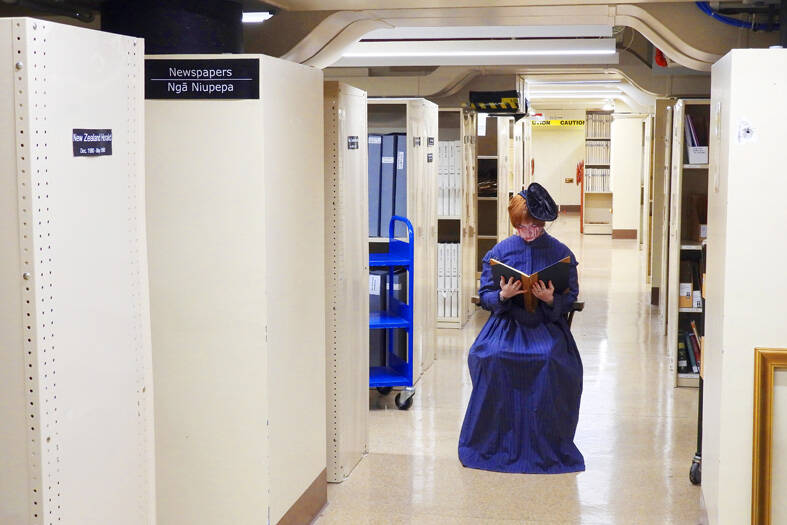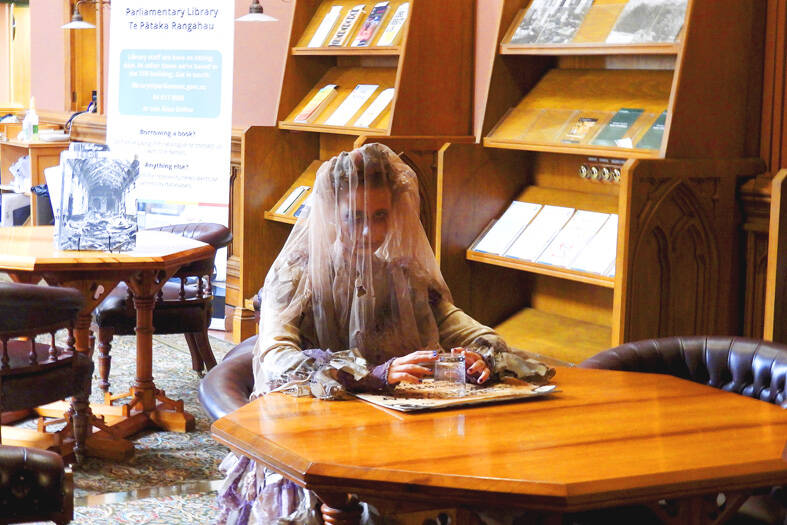A veiled woman burst screaming from an elevator. The small crowd gathered in a basement corridor of New Zealand ’s parliament drew back nervously.
Their guide, wearing a trailing, white gown, smiled sweetly.
“You’re welcome to take the elevator,” she said.

Photo: AP
Nobody did.
Mysterious deaths, unexplained noises and late-night apparitions are not the usual fodder of daily tours offered at the parliament buildings in Wellington. However, after hours on Thursday, guides donned Victorian-era garb to regale visitors with the precinct’s less savory history — “mostly factual” tales of real-world tragedy and paranormal lore that have grown established among political staffers through decades of colorful retelling.
The history of parliament’s stately gothic library is particularly rich in woe. Constructed in the late 19th century and feared by some of parliament’s night shift security guards and cleaners, it has survived two fires, a flood and being overrun by feral cats.

Photo: AP
“This is your last chance to back out,” Lisa Brand, her face dripping with fake blood, told the group on Thursday’s tour — a recent initiative and one embraced by the visitors’ center staff with gusto.
Walking through a cavernous parliamentary atrium, the guide let out a hair-raising scream that echoed up to the open windows of lawmakers’ offices. It explained why the so-called spooky tours are reserved for weeks when parliament is not in session.
The Parliamentary Library is a gloomy and ornate building where stained-glass windows and crystal chandeliers dimly reveal wrought iron bannisters and Venetian decor. Designed by Thomas Turnbull and completed in 1899, it remains in use by staff seeking information or some slightly eerie peace and quiet.
When the visitors arrived, they were greeted by spectral figures who shrieked as they glided down staircases beneath the portraits of former head librarians and New Zealand prime ministers. Tour guides told a hushed audience that the library was imperiled by a savage storm that struck Wellington in 1968 — sinking a passenger ferry in the harbor with the deaths of 53 people.
The tempest lashed parliament, too, tearing out skylights and prompting librarians to climb onto the roof as they tried to protect the books, said a guide, who sported Victorian garb and dark shadows under her eyes.
“For mysterious and unknown reasons they did this in their underwear,” she told the visitors. “There seems to be a history of people losing their pants here in this parliament.”
“I haven’t even started on the politicians,” the guide added, with relish.
Eventually the tour turned to lawmakers. Well-known in New Zealand is the story of William Larnach, a politician who in 1898 was found dead in a room at parliament with a revolver in his hand while experiencing financial and family strife.
Some claim that Larnach’s ghost remains in the building. However, his skull was stolen — and in 1972 was rediscovered in a college student’s bedroom.
Another spirit reported to linger is that of the first full-time librarian, Ewen McColl, whose death was partly attributed by some official sources to overwork.
As the tour descended to the building’s basement, the ceilings grew low and the corridors narrow. Frantic banging resounded from an apparently locked room.
The subterranean floors are home to an archive containing the historical and esoteric.
It is also the site of some of the building’s strangest reported occurrences, tour guides said.
Urban legends passed down by staff include stories of hands reaching out from the stacks, songs emanating from empty bathrooms, the apparition of a ghostly woman in a mirror, and locked doors swinging open. More earthly horrors included a cat, and subsequent flea, infestation in 1977.
After one last fright, visitors emerged slightly shaken into parliament’s near-empty lobby as darkness fell.
The tour was “a bit spookier than I expected,” said Holly Masters, who had last visited parliament as a child. “There was quite a few deaths here that I did not expect to find out about.”
Another visitor, Sally Giles, said she was fascinated to learn the stories of those who worked and died in the precinct “and what they’ve left behind and how that surfaces every now and then.”

Incumbent Ecuadoran President Daniel Noboa on Sunday claimed a runaway victory in the nation’s presidential election, after voters endorsed the young leader’s “iron fist” approach to rampant cartel violence. With more than 90 percent of the votes counted, the National Election Council said Noboa had an unassailable 12-point lead over his leftist rival Luisa Gonzalez. Official results showed Noboa with 56 percent of the vote, against Gonzalez’s 44 percent — a far bigger winning margin than expected after a virtual tie in the first round. Speaking to jubilant supporters in his hometown of Olon, the 37-year-old president claimed a “historic victory.” “A huge hug

Two Belgian teenagers on Tuesday were charged with wildlife piracy after they were found with thousands of ants packed in test tubes in what Kenyan authorities said was part of a trend in trafficking smaller and lesser-known species. Lornoy David and Seppe Lodewijckx, two 19-year-olds who were arrested on April 5 with 5,000 ants at a guest house, appeared distraught during their appearance before a magistrate in Nairobi and were comforted in the courtroom by relatives. They told the magistrate that they were collecting the ants for fun and did not know that it was illegal. In a separate criminal case, Kenyan Dennis

A judge in Bangladesh issued an arrest warrant for the British member of parliament and former British economic secretary to the treasury Tulip Siddiq, who is a niece of former Bangladeshi prime minister Sheikh Hasina, who was ousted in August last year in a mass uprising that ended her 15-year rule. The Bangladeshi Anti-Corruption Commission has been investigating allegations against Siddiq that she and her family members, including Hasina, illegally received land in a state-owned township project near Dhaka, the capital. Senior Special Judge of Dhaka Metropolitan Zakir Hossain passed the order on Sunday, after considering charges in three separate cases filed

APPORTIONING BLAME: The US president said that there were ‘millions of people dead because of three people’ — Vladimir Putin, Joe Biden and Volodymyr Zelenskiy US President Donald Trump on Monday resumed his attempts to blame Ukrainian President Volodymyr Zelenskiy for Russia’s invasion, falsely accusing him of responsibility for “millions” of deaths. Trump — who had a blazing public row in the Oval Office with Zelenskiy six weeks ago — said the Ukranian shared the blame with Russian President Vladimir Putin, who ordered the February 2022 invasion, and then-US president Joe Biden. Trump told reporters that there were “millions of people dead because of three people.” “Let’s say Putin No. 1, but let’s say Biden, who had no idea what the hell he was doing, No. 2, and